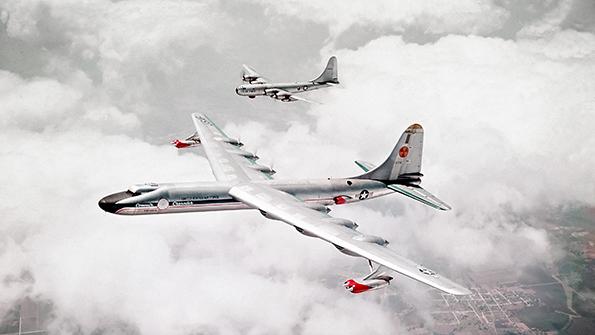
Ask the Editors: The Aviation Week Network invites our readers to submit questions to our editors and analysts. We’ll answer them, and if we can’t we’ll reach out to our wide network of experts for advice.
What are the prospects for nuclear propulsion for aircraft? It would give unlimited endurance and range for unmanned aircraft.
Executive Editor, Technology, Graham Warwick responds:
Russia claims to have test-flown a nuclear-powered cruise missile, the Burevestnik, and NASA is developing an unmanned rotorcraft to explore Saturn’s moon Titan powered by a radioisotope thermoelectric generator. So nuclear propulsion, in one form or another, is a reality.
The U.S. Air Force flew a nuclear fission reactor in a modified Convair B-36 bomber, the NB-36H, in 1955 (pictured). The program was eventually canceled, but researchers regularly dust off the idea of nuclear propulsion for infinite-endurance and zero-hydrocarbon flight.
In 2014, NASA revealed studies of propulsion systems and aircraft concepts using low-energy nuclear reactions, sometimes called cold fusion. And Lockheed Martin’s Skunk Works is working to develop a compact fusion reactor small enough to power a C-5-size aircraft.
There are other ways to use nuclear power in aircraft propulsion. One would be to use the advanced small modular reactors (SMR) now in development to generate electrical power at air bases or airports. These mobile microreactors could be used to recharge electric aircraft. Another would be to use the electrical power from an SMR to generate hydrogen by electrolyzing water and then combining this with carbon dioxide captured from the atmosphere to produce liquid fuels. This power-to-liquid fuel would be a drop-in replacement for jet fuel.






Comments
On the other hand, commercial aviation should very soon begin a coordinated effort to buy carbon offsets, ultimately working to completely offset the almost 3% of the world's green house gas emissions the industry generates. This cost would be rolled into ticket prices and the actual offset work would be made a highly visible part of aviations promotions.
A good example: higher airline ticket price could build solar-powered microgrids in Africa to eliminate the massive deforestation taking place to support the growing population of that region. Trees are a critically-important CO2 absorber, but trees are disappearing fast all across Africa, with the wood being used for cooking and heating. A coordinated carbon offset program could stop deforestation and actually support reforestation through new companies that pay locals to plant and maintain forests. Such a program would also free African women of their role of collecting firewood. Those long hours could go towards better education and badly-need family planning.
Commercial aviation can have a bright future, but it must use this current crisis to organize a path ahead....and the path MUST include a highly-visible drive to carbon neutrality.